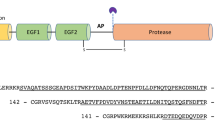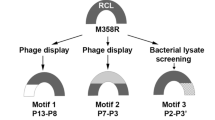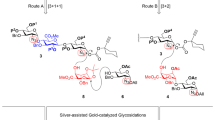Abstract
Antithrombin, the principal physiological inhibitor of the blood coagulation proteinase thrombin, requires heparin as a cofactor. We report the crystal structure of the rate-determining encounter complex formed between antithrombin, anhydrothrombin and an optimal synthetic 16-mer oligosaccharide. The antithrombin reactive center loop projects from the serpin body and adopts a canonical conformation that makes extensive backbone and side chain contacts from P5 to P6′ with thrombin's restrictive specificity pockets, including residues in the 60-loop. These contacts rationalize many earlier mutagenesis studies on thrombin specificity. The 16-mer oligosaccharide is just long enough to form the predicted bridge between the high-affinity pentasaccharide-binding site on antithrombin and the highly basic exosite 2 on thrombin, validating the design strategy for this synthetic heparin. The protein-protein and protein-oligosaccharide interactions together explain the basis for heparin activation of antithrombin as a thrombin inhibitor.
This is a preview of subscription content, access via your institution
Access options
Subscribe to this journal
Receive 12 print issues and online access
$189.00 per year
only $15.75 per issue
Buy this article
- Purchase on Springer Link
- Instant access to full article PDF
Prices may be subject to local taxes which are calculated during checkout





Similar content being viewed by others
References
Olson, S.T. & Björk, I. Mechanism of action of heparin and heparin-like antithrombotics. Persp. Drug Discovery Design 1, 479–501 (1994).
Levine, M.N. & Hirsh, J. Clinical use of low molecular weight heparins and heparinoids. Sem. Thromb. Hemost. 14, 116–125 (1988).
Gettins, P.G.W. Serpin structure, mechanism and function. Chem. Rev. 102, 4751–4804 (2002).
Desai, U., Petitou, M., Björk, I. & Olson, S.T. Mechanism of heparin activation of antithrombin. Role of individual residues of the pentasaccharide in the recognition of native and activated states of antithrombin. J. Biol. Chem. 273, 7478–7487 (1998).
Desai, U., Petitou, M., Björk, I. & Olson, S.T. Mechanism of heparin activation of antithrombin. Evidence for an induced-fit model of allosteric activation involving two interaction subsites. Biochemistry 37, 13033–13041 (1998).
Huntington, J.A., Olson, S.T., Fan, B. & Gettins, P.G.W. Mechanism of heparin activation of antithrombin. Evidence for reactive center loop pre-insertion with expulsion upon heparin binding. Biochemistry 35, 8495–8503 (1996).
Olson, S.T. & Björk, I. Predominant contribution of surface approximation to the mechanism of heparin acceleration of the antithrombin-thrombin reaction. Elucidation from salt concentration effects. J. Biol. Chem. 266, 6353–6364 (1991).
Herbert, J.M. et al. SR123781A, a synthetic heparin mimetic. Thromb. Haemost. 85, 852–860 (2001).
Petitou, M. et al. Synthesis of thrombin-inhibiting heparin mimetics without side effects. Nature 398, 417–422 (1999).
Grootenhuis, P.D.J., Westerduin, P., Meuleman, D., Petitou, M. & van Boeckel, C.A. Rational design of synthetic heparin analogues with tailor-made coagulation inhibitory activity. Nat. Struct. Biol. 2, 736–739 (1995).
Olson, S.T., Halvorson, H.R. & Björk, I. Quantitative characterization of the thrombin-heparin interaction. Discrimination between specific and nonspecific binding models. J. Biol. Chem. 266, 6342–6352 (1991).
Jin, L. et al. The anticoagulant activation of antithrombin by heparin. Proc. Natl. Acad. Sci. USA 94, 14683–14688 (1997).
Baglin, T.P., Carrell, R.W., Church, F.C., Esmon, C.T. & Huntington, J.A. Crystal structure of native and thrombin-complexed heparin cofactor II reveal a multistep allosteric mechanism. Proc. Natl. Acad. Sci. USA 99, 11079–11084 (2002).
Skinner, R. et al. The 2.6Å structure of antithrombin indicates a conformational change at the heparin binding site. J. Mol. Biol. 266, 601–609 (1997).
Ye, S. et al. The structure of a Michaelis serpin–protease complex. Nature Struct. Biol. 8, 979–983 (2001).
Dementiev, A., Simonovic, M., Volz, K. & Gettins, P.G.W. Canonical inhibitor-like interactions explain reactivity of α1-proteinase inhibitor Pittsburgh and antithrombin with proteinases. J. Biol. Chem. 278, 37881–37887 (2003).
Rezaie, A.R. Role of Leu99 of thrombin in determining the P2 specificity of serpins. Biochemistry 36, 7437–7446 (1997).
Chuang, Y.-J., Gettins, P.G.W. & Olson, S.T. Importance of the P2 glycine of antithrombin in target proteinase specificity, heparin activation and the efficiency of proteinase trapping as revealed by a P2 Gly→Pro mutation. J. Biol. Chem. 274, 28142–28149 (1999).
Carrell, R.W., Stein, P.E., Fermi, G. & Wardell, M.R. Biological implications of a 3Å structure of dimeric antithrombin. Structure 2, 257–270 (1994).
Skinner, R. et al. Implications for function and therapy of a 2.9Å structure of binary-complexed antithrombin. J. Mol. Biol. 283, 9–14 (1998).
Huntington, J.A., McCoy, A., Pei, X., Gettins, P.G.W. & Carrell, R.W. 2.85Å structure of antithrombin variant S380C-fluorescein reveals the trigger for allosteric activation. J. Biol. Chem. 275, 15377–15383 (1999).
Schreuder, H.A. et al. The intact and cleaved human antithrombin III complex as a model for serpin-proteinase interactions. Nat. Struct. Biol. 1, 48–54 (1994).
Casu, B. et al. The structure of heparin oligosaccharide fragments with high anti-(factor Xa) activity containing the minimal antithrombin III-binding sequence. Chemical and 13C nuclear magnetic resonance studies. Biochem. J. 197, 599–609 (1981).
Choay, J. et al. Structure-activity relationship in heparin: a synthetic pentasaccharide with high affinity for antithrombin III and eliciting high anti-factor Xa activity. Biochem. Biophys. Res. Commun. 116, 492–499 (1983).
Laurent, T.C., Tengblad, A., Thunberg, L., Höök, M. & Lindahl, U. The molecular weight dependence of the anti-coagulant activity of heparin. Biochem. J. 175, 691–701 (1978).
Sheehan, J.P. & Sadler, J.E. Molecular mapping of the heparin-binding exosite of thrombin. Proc. Natl. Acad. Sci. USA 91, 5518–5522 (1994).
Petitou, M., Lormeau, J.-C. & Choay, J. Chemical synthesis of glycosaminoglycans: New approaches to antithrombic drugs. Nature 350 (suppl.), 30–33 (1991).
Li, W., Johnson, D.J.D., Esmon, C.T. & Huntington, J.A. 2.5Å structure of the antithrombin–thrombin–heparin ternary complex reveals the antithrombotic mechanism of heparin. Nat. Struct. Mol. Biol. 11, advance online publication, 15 August 2004 (doi:10.1038/nsmb811).
Rezaie, A.R. Reactivities of the S2 and S3 subsite residues of thrombin with the native and heparin-induced conformers of antithrombin. Protein Sci. 7, 349–357 (1998).
Rezaie, A.R. & Olson, S.T. Contribution of lysine 60f to S1′ specificity of thrombin. Biochemistry 36, 1026–1033 (1997).
Rezaie, A.R. Tryptophan 60-D in the B-insertion loop of thrombin modulated the thrombin-antithrombin reaction. Biochemistry 35, 1918–1924 (1996).
Marqu, P.-E., Spuntarelli, R., Juliano, L., Aiach, M. & Le Bonniec, B.F. The role of Glu192 in the allosteric control of the S2′ and S3′ subsites of thrombin. J. Biol. Chem. 275, 809–816 (2000).
Bode, W., Turk, D. & Karshikov, A. The refined 1.9Å X-ray crystal structure of D-Phe-Pro-Arg-chloromethylketone-inhibited human α-thrombin: structure analysis, overall structure, electrostatic properties, detailed active-site geometry, and structure-function relationships. Protein Sci. 1, 426–471 (1992).
He, X.H., Ye, J., Esmon, C.T. & Rezaie, A.R. Influence of arginines 93, 97, and 101 of thrombin to its functional specificity. Biochemistry 36, 8969–8976 (1997).
Meagher, J.L., Huntington, J.A., Fan, B. & Gettins, P.G.W. Role of arginine 132 and lysine 133 in heparin binding to, and activation of, antithrombin. J. Biol. Chem. 271, 29353–29358 (1996).
Ngai, P.K. & Chang, J.-Y. A novel one-step purification of human α-thrombin after direct activation of crude prothrombin enriched from plasma. Biochem. J. 280, 805–808 (1991).
Ashton, R.W. & Scheraga, H.A. Preparation and characterization of anhydrothrombin. Biochemistry 34, 6454–6463 (1995).
Otwinowski, Z. & Minor, W. Processing of x-ray diffraction data collected in oscillation mode. Methods Enzymol. 276, 461–472 (1997).
Brünger, A.T. Crystallography & NMR system: a new software suite for macromolecular structure determination. Acta Crystallogr. D 54, 905–921 (1998).
Choay, J., Lormeau, J.-C. & Petitou, M. Low molecular weight oligosaccharides active in plasma against factor Xa. Ann. Pharm. Fr. 39, 37–44 (1981).
Acknowledgements
This work was supported by grants HL49234 and HL64013 from the US National Institutes of Health. Data were collected on the SERCAT ID beamline at the Advanced Photon Source (APS), Argonne National Laboratory. Use of APS is supported by the US Department of Energy.
Author information
Authors and Affiliations
Corresponding author
Ethics declarations
Competing interests
M.P. and J.-M.H. are currently employees of Sanofi, the manufacturer of the heparin mimetic SR123781A, which was used in this study.
Rights and permissions
About this article
Cite this article
Dementiev, A., Petitou, M., Herbert, JM. et al. The ternary complex of antithrombin–anhydrothrombin–heparin reveals the basis of inhibitor specificity. Nat Struct Mol Biol 11, 863–867 (2004). https://doi.org/10.1038/nsmb810
Received:
Accepted:
Published:
Issue Date:
DOI: https://doi.org/10.1038/nsmb810
This article is cited by
-
ANISERP: a new serpin from the parasite Anisakis simplex
Parasites & Vectors (2015)
-
Structural characterization of human heparanase reveals insights into substrate recognition
Nature Structural & Molecular Biology (2015)
-
A specific antidote for reversal of anticoagulation by direct and indirect inhibitors of coagulation factor Xa
Nature Medicine (2013)
-
Docking glycosaminoglycans to proteins: analysis of solvent inclusion
Journal of Computer-Aided Molecular Design (2011)



